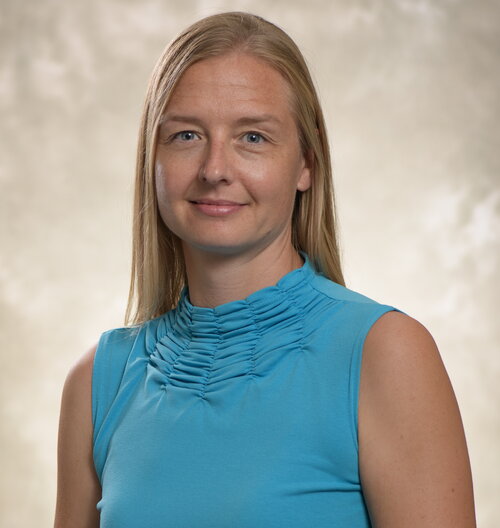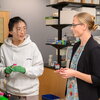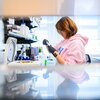
Contact Information
600 S. Mathews Avenue, MC-712 B-4
Urbana, IL 61801
Research Interests
Research Topics
Host-Pathogen Interactions, Molecular Immunology, Protein Dynamics, Protein Structure, Virology
Disease Research Interests
Infectious Diseases
Research Description
The Stadtmueller Lab aims to broaden understanding of immune system proteins, their interactions with microbes and the functional outcomes of those interactions. Specifically, the Stadtmueller Lab investigates the assembly, structures and functions of mucosal antibodies in order to understand how these remarkable complexes protect vertebrates from external factors (e.g. pathogens) and how they can be engineered to treat disease. To accomplish this the lab targets data detailing the structures and biophysical mechanisms of mucosal antibodies from different species as well as mucosal antibody interactions with bacterial and viral antigens and receptors. Common approaches used in the lab include but are not limited to antibody engineering, cryoelectron microscopy, X-ray crystallography, surface plasmon resonance and fluorescence microscopy. Together, Stadtmueller lab projects are expanding our understanding of host-microbe co-evolution, antibody structure-function relationships and antibody therapeutic potential. Please visit our webpage for more information.
Education
B.S. 2003 University of Wisconsin, Madison
Ph.D. 2010 University of Utah
Postdoc. 2011-2018 California Institute of Technology
External Links
Highlighted Publications
Representative Publications
Kumar Bharathkar, S.*, Parker, B. W.*, Malyutin, A. G., Haloi, N., Huey-Tubman, E. K., Tajkhorshid, E., Stadtmueller, B. M. (2020). "The structures of secretory and dimeric immunoglobulin A." Elife 9. https://elifesciences.org/articles/56098
Stadtmueller B.M. , Bridges M.D., Dam K-M., Lerch M.T., Huey-Tubman K.E., Hubbell W.L., Bjorkman P.J. (2018) DEER Spectroscopy Measurements Reveal Multiple Conformations of HIV-1 SOSIP Envelopes that Show Similarities with Envelopes on Native Virions. Immunity. 2018 Jul 26. [Epub ahead of print] https://www.ncbi.nlm.nih.gov/pubmed/30076100
Stadtmueller, B.M. , Yang, Z., Huey-Tubman, K.E., Roberts-Mataric, H., Hubbell, W.L., and Bjorkman, P.J. (2016). Biophysical and biochemical characterization of avian secretory component provides structural insights into the evolution of the polymeric Ig receptor. J Immunol. 197(4): 1408-1414. http://www.ncbi.nlm.nih.gov/pubmed/27412418
Featured “In this Issue:” http://www.jimmunol.org/content/197/4/1007
Stadtmueller, B.M. , Huey-Tubman, K.E., Lopez, C.J., Yang, Z., Hubbell, W.L., and Bjorkman, P.J. (2016). The structure and dynamics of secretory component and its interactions with polymeric immunoglobulins. eLife 5. https://www.ncbi.nlm.nih.gov/pubmed/26943617 Featured in Caltech News: https://www.caltech.edu/news/multitasking-protein-keeps-immune-system-h…
Stadtmueller, B.M.* , Kish-Trier E.*, Ferrell K., Robinson H., Myszka D.G., Formosa, T. Hill, C.P. (2012) Crystal structure of the Pba1/2-proteasome complex and implications for HbYX-dependent proteasome interactions. J Biol Chem 287(44):37371-82. https://www.ncbi.nlm.nih.gov/pubmed/22930756
Stadtmueller, B.M. and Hill, C.P. (2011) “Proteasome Activators.” Mol Cell 41(1): 8-19. https://www.ncbi.nlm.nih.gov/pubmed/21211719
Stadtmueller, B. M. , Ferrell K., Whitby F.G., Heroux A., Robinson H., Myszka D.G., Hill C.P. (2010) Structural models for interactions between the 20S proteasome and its PAN/19S activators. J Biol Chem 285(1): 13-7. https://www.ncbi.nlm.nih.gov/pubmed/19889631
Recent Publications
Bharathkar, S. K., & Stadtmueller, B. M. (2024). Structural and Biochemical Requirements for Secretory Component Interactions with Dimeric IgA. Journal of Immunology, 213(2), 226-234. https://doi.org/10.4049/jimmunol.2300717
Hockenberry, A., Slack, E., & Stadtmueller, B. M. (2023). License to Clump: Secretory IgA Structure-Function Relationships Across Scales. Annual review of microbiology, 77, 645-668. https://doi.org/10.1146/annurev-micro-032521-041803
Liu, Q., & Stadtmueller, B. M. (2023). SIgA structures bound to Streptococcus pyogenes M4 and human CD89 provide insights into host-pathogen interactions. Nature communications, 14(1), Article 6726. https://doi.org/10.1038/s41467-023-42469-y
Lyu, M., Malyutin, A. G., & Stadtmueller, B. M. (2023). The structure of the teleost Immunoglobulin M core provides insights on polymeric antibody evolution, assembly, and function. Nature communications, 14(1), Article 7583. https://doi.org/10.1038/s41467-023-43240-z
Diefenbacher, M., Tan, T. J. C., Bauer, D. L. V., Stadtmueller, B. M., Wu, N. C., & Brooke, C. B. (2022). Interactions between Influenza A Virus Nucleoprotein and Gene Segment Untranslated Regions Facilitate Selective Modulation of Viral Gene Expression. Journal of virology, 96(10). https://doi.org/10.1128/jvi.00205-22




